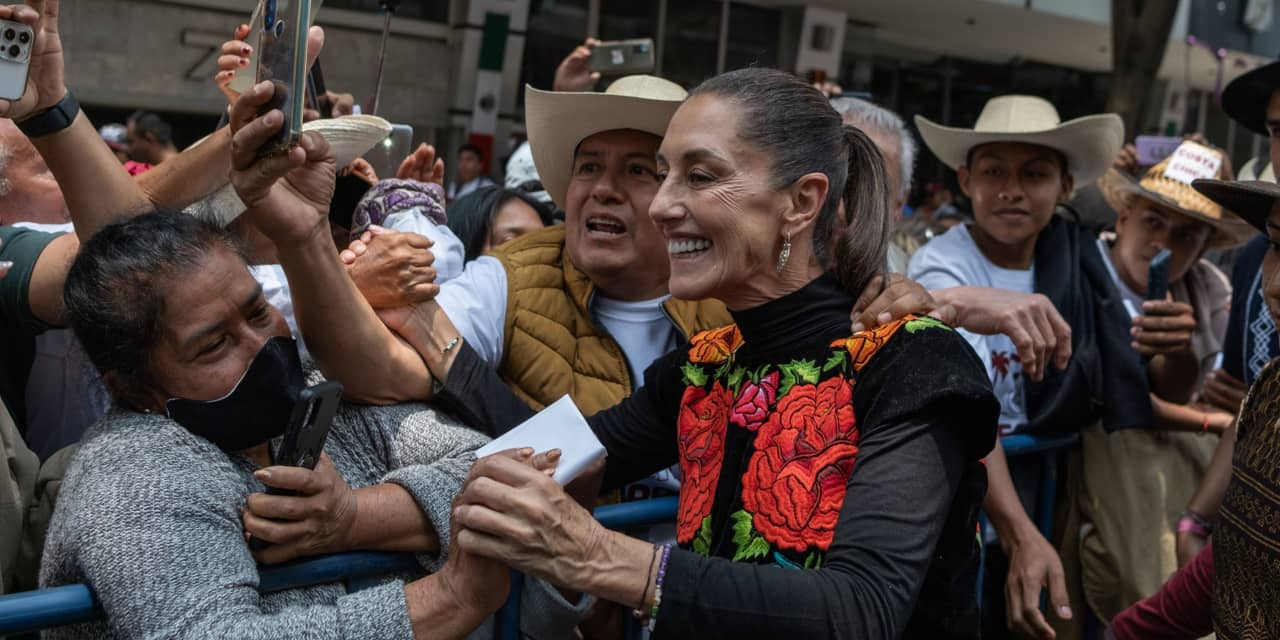You might not know it from listening to the U.S. chatter, but Mexico is in good hands.
The latest political news from our southern neighbor was no surprise: The governing Morena party tapped former Mexico City Mayor Claudia Sheinbaum as its candidate to succeed Andres Manuel Lopez Obrador in presidential elections next June. What is surprising is the sound economy that AMLO, as the incumbent leader is known, looks set to leave behind.
Mexican gross domestic product is on track for a second year of 3% growth. The
iShares MSCI Mexico
exchange-traded fund (ticker: EWW) has climbed by a quarter over the past 12 months. The peso is up 14% against the dollar, even as the greenback dominates most world currencies. Inflation has halved to 4.6% annually, leaving the central bank plenty of room to cut its 11.25% prime rate.
Not bad for a self-proclaimed leftist revolutionary.
Neither Sheinbaum nor her principal opponent, center-right coalition candidate Xochitl Galvez, threatens to botch this legacy, so far as markets can tell. “Mexico should be seen as a geopolitical opportunity, not a problem,” says Matt Gertken, geopolitical strategist at BCA Research. “You’re looking at two credible candidates to take over.”
The opponents-to-be have a lot in common, aside from being female and nearly the same age. Both have their roots in engineering with a tilt toward sustainability. Sheinbaum, 61, earned a Ph.D. in energy engineering and contributed to the pioneering Intergovernmental Panel on Climate Change. Galvez, 60, was a programmer who founded a company designing intelligent buildings before turning to politics.
Sheinbaum, though regarded as AMLO’s handpicked heir, lacks her mentor’s penchant for personal public feuds, notably with business leaders. “She’s less combative,” says Malcolm Dorson, head of emerging markets strategy at Global X exchange-traded funds. “I don’t see her calling people out on the national stage.”
Galvez, though a pro-business entrepreneur, also plays on her upbringing in a poor indigenous family. “There will be a race for who can sound more populist,” says Sarah Glendon, senior sovereign analyst for Latin America at Columbia Threadneedle Investments. “But I’m not very concerned about a major shift in policy-making.”
AMLO’s great achievement, from markets’ point of view, has been more-or-less pulling off his program of “republican austerity.” Social spending’s share of Mexico’s federal budget has more than tripled without a “fiscal blowout,” Gertken says. The deficit-to-GDP ratio has doubled during Lopez Obrador’s tenure to more than 4%. But investment inflows have kept government debt to an acceptable 50% of GDP.
Investors and the public are both happy so far. AMLO heads into his final year with 60% approval ratings, making Sheinbaum the favorite to succeed him. (Mexican presidents are constitutionally limited to a single six-year term.)
AMLO’s biggest shortcoming has been a perceived hostility toward private enterprise, which may have kept Mexico from jumping more aggressively on “nearshoring” opportunities as U.S. corporations look for alternatives to Chinese supply chains. “There’s lots of optimism about nearshoring, but we haven’t seen it come through yet,” Glendon says.
Softer rhetoric from the next president might improve the climate somewhat. “Mexican management teams are very much looking forward to change no matter who it is,” Dorson says.
Some policy changes are also called for though—particularly reopening Mexico’s oil and gas sector to foreign investors. This opening was a key achievement of AMLO’s predecessor, Enrique Peña Nieto. AMLO restored the monopoly of state driller Pemex. There’s not much hope Sheinbaum would reverse her mentor on such an emotional issue.
Eight of Mexico’s top 10 nearshoring investments are in the automotive sector, Dorson reports,
Tesla’s
(TSLA) $5 billion commitment in the northern state of Nueva Leon being by far the largest. Signs of diversity to other industries are scant.
Dorson is all in on the nearshoring story nonetheless. “We keep pounding the table that India and Mexico are the best structural opportunities in emerging markets,” he says.
He’s investing in stocks geared to macroeconomic growth, like No. 2 bank
Grupo Financiero Banorte
(GFNORTEO.Mexico), which offers a 7.5% dividend yield at “incredibly attractive valuations,” retailer
Wal-Mart de Mexico
(Walmex.Mexico), and developer
Corp Inmobiliaria Vesta
(VESTA.Mexico).
Approaches to Mexican fixed income depend on when you think the central bank might start an easing cycle. Banxico, as it is known, kept hiking even as inflation dropped early this year, setting up a highly attractive “carry” trade to support the peso.
Fund managers at
Artisan Partners
see cuts coming no later than February, making now the time to shift out of the peso into bonds, whose prices rise as interest rates fall. “We like local rates a lot and expect a rally as Banxico changes its policy stance,” they tell Barron’s.
What’s clear is that Mexico heads toward the end of the AMLO era in better shape than markets feared at the start.
Write to editors@barrons.com
Read the full article here













Leave a Reply